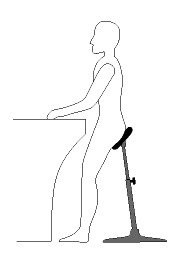허리가 불편해진 이후로 이번 기회에 아예 앉는 자세를 교정해보고자 합니다.
하여, 이런저런 검색을 해보고 있죠.
제겐 요 근래의 최대 관심사이기도 합니다.
찾던 중 저 밑에 박스 속의 같은 글을 발견했습니다.
결론부터 말씀드리자면 우리가 일반적으로 앉는 의자는 일반적으로 허벅지가 바닥면과 수평인 자세가 나오는데, 그런 자세보다 허벅지가 아래로 경사지는 자세가 척추에는 더 좋다는 겁니다.
그런 자세의 장점에 대해서도 기술을 해놨고, 그림으로도 어떻게 앉으라고도 친절하게 설명하고 있네요.
그런데 그 각도가 중요하다고 합니다.
일반 의자에서 허벅지의 각도를 10도 정도로 유지하면서 앉으면 좋은데, 그보다 각도를 벌리지는 말랍니다.
또한 닐링 의자 (제가 요즘 삘 받은 꿇어앉아 의자)의 경우 초창기엔 30도 정도의 경사를 주고 형태도 아래 그림과 같이 생겼었나봅니다.
그런 자세를 취할경우 척추의 정렬에도 도움이 되는 장점이 있는 반면에, 이렇게 각도가 크면 정강이의 특정 부위에 하중이 많이 실리게 되고 앉고 서기도 불편하고 등등의 단점이 있다고 지적하네요.
근데 제가 요즘 삘 받은 의자는 그 각도가 20도 정도로 알고 있습니다.
과연 그 의자가 얼마나 제게 잘 맞을지 모르겠지만 일단은 삘은 받은 상태입니다ㅡ.ㅡ;
제가 좀 뭐 하나 사려면 열라 공부하고 알아보고 장단점, 가격 뭐 이런거 꼬치꼬치 따지는 습관이 있어서 여기저기 자료 찾고 뭐 그러고 있습니다ㅡ.ㅡ;
그나저나 맨 아래에 있는 그림에서 다리에 부착하는 임시 의자는 참 신선한 아이디어네요^^
|
제목: Working in a Sitting Position - Alternative Chairs |
|
What are examples of "alternative" chairs?
The forward sloping chair and the kneeling chair are alternatives for workers who sit continuously. A saddle chair (sit-stand seat) allows a worker to alternate between sitting and standing.
What is a forward sloping chair?
| A forward sloping chair has a mechanism that allows the user to adjust the tilt of the seat pan forward. The angle of tilt from the horizontal should not be greater than 10 degrees. |
|
What are some advantages of a forward sloping chair?
The use of a forward sloping chair:
- Increases the number of possible positions.
- Provides better alignment for spine.
- Improves visual distance and angle to the task on a worktable.
- Improves head position.
- Improves return blood flow from the lower legs.
- Decreases pressure on internal organs.
What are some disadvantages of a forward sloping chair?
The use of a forward sloping chair:
- Places more weight on legs to control forward tilt of the upper body, and may result in earlier development of tiredness.
- May cause the body to slide forward; however, if the seat pan of such a chair is curved from front to back, it would allow you to sit without sliding. Nevertheless, you do have do exert some muscular effort in your lower legs to remain seated. This effort is in fact beneficial (providing the slope is not greater than 15 degrees) because it improves the return blood flow from your lower legs.
- May cause clothing to ride up legs.
What is a kneeling chair?
| A kneeling chair has a fixed seat sloping at 30 degrees forward and padded support for knees. |
|
What are some advantages of a kneeling chair?
A kneeling chair:
- Provides proper alignment for the spine.
- May be good for some people if fitted to the individual.
- Provides considerable comfort for short periods of time.
What are some disadvantages of a kneeling chair?
A kneeling chair:
- Causes shins to bear weight.
- Over-flexes knees and ankles.
- Limits the number of possible sitting positions.
- May cause fatigue to develop earlier.
- May cause clothing to ride up legs.
- Makes getting in and out of the chair difficult.
- Reduces the range of reaches.
When would you use a saddle chair or a sit-stand seat?
| A saddle chair can be used where the worker can alternate between sitting and standing in his or her work.
A saddle chair:
- reduces fatigue by decreasing muscular effort
- improves alignment of the spine
|

|
Combining the saddle chair with a tilted worktable, where possible, is beneficial because it:
- improves the head position and
- reduces stress on shoulders and neck.
|
|
Alternate sitting and standing frequently.
Are there some other things I should know about alternative seating?
There are situations when rest chairs and sitting/kneeling support should be made available.
Rest Chair
| It is desirable to have a chair for resting even when work can only be done standing. If space is limited, then chair that can be folded up and stored out of the way can be used. |
| Sitting/Kneeling Support
Making hip support available where the work requires kneeling:
- reduces tension in the thigh muscles, by widening the angle of the knees
- reduces compression on the knees, ankles and lumbar region (middle to lower back)
- improves blood circulation
|
|
- Do not maintain kneeling/sitting position for extended periods.
- Avoid bending.
- Stand up and walk whenever possible.
|
.gif)
|
| Canadian Centre for Occupational Health and Safety |
www.ccohs.ca |
|
Inquiries and Client Services
[email protected]
1-800-668-4284
905-570-8094
Fax: 905-572-4500 |
|
Document last updated on April 16, 2007
Copyright ©1997-2008 Canadian Centre for Occupational Health & Safety
|
|
출처:
http://www.ccohs.ca/oshanswers/ergonomics/sitting/sitting_alternative.html?print |